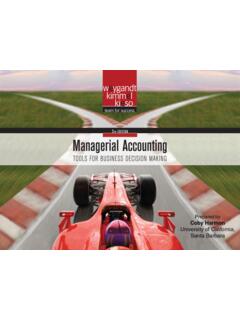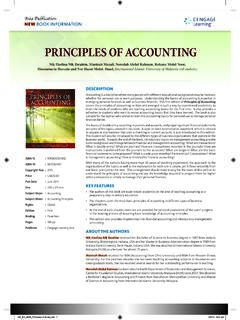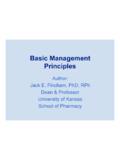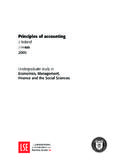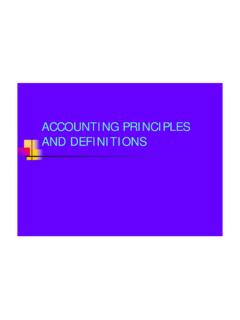Transcription of 1 ACCOUNTING PRINCIPLES CONCEPTS AND CONVENTIONS
1 1 ACCOUNTINGPRINCIPLES, CONCEPTS ANDCONVENTIONSTHISCHAPTERINCLUDES Definition of ACCOUNTING Objectives of ACCOUNTING Function of ACCOUNTING Book-Keeping ACCOUNTING Cycle ACCOUNTING - Classification Basis of ACCOUNTING Basic ACCOUNTING Terms ACCOUNTING PRINCIPLES ACCOUNTING CONCEPTS American Institute ofCertified Public Accountants-Accountingis theartofrecording,classifyingand summarizing in a significant manner andintermsofmoney,transactionsandeventsw hichareinpartat least, of a financialcharacterandinterpretingtheresu ltsthereof . (attributes) ofAccounting(i) ACCOUNTING records transactions andevents which are of financial nature.
2 (ii) ACCOUNTING is an art.(iii)Itinvolvesthefollowingactivitie s:recording, classifying and summarizing(iv) Solved Scanner CMA Foundation Paper - 2(New Syllabus)financialpositionofanenterprise byanalysing and interpreting thesummarizedrecordsandcommuni-cating them to users.(v) ACCOUNTING information can bemanipulatedand thus cannot beconsidered as the true test ofperformance.(vi)Itrecordstransactionsi ntermsofmoney. ofAccounting(i)Maintaining ACCOUNTING records(ii)Ascertainingprofit/lossofthee nterprise(iii)Ascertainingthefinancialpo sitionoftheenterprise(iv) ofAccounting(i)Maintaining systematic records(ii)Protectingandcontrollingbusin essproperties(iii)Ascertaining the operational profit/loss(iv)Ascertaining financial position(v)Facilitating rational decision ofAccounting(i)Providesfinancialinformat ionaboutthebusiness to interested parties(ii)
3 Helpsincomparisonoffinancialresults Comparisonofitsownresultsofdifferent years Comparisonof financial results withother firms in the industry(iii)Helps in decision making(iv) ACCOUNTING informationcanbe used asan evidence in legal & Taxation matter[Chapter 1] ACCOUNTING PRINCIPLES , CONCEPTS (v)Helps in valuation of the business(vi) (Limitations ofAccounting)(i)Accountingignoresnonmone tarytransactions(ii)Accountinginformatio nissometimesbasedonestimates which may beunrealistic(iii)WindowDressingmay lead to faultyresults.(iv)Accountingignorestheef fect of pricelevelchangesastherecordings at historical cost.
4 (v) ACCOUNTING information can bemanipulatedandthuscannotbeconsideredas the true test ofperformance. it may be (vi) Information is not withoutpersonal influence or bias Bookkeeping is a branch of done by junior employees. Itisconcernedwithrecordingfinancialdata of the business in a significant andorderly manner. Itismeanttoshowthe effect of all Solved Scanner CMA Foundation Paper - 2(New Syllabus)periodonthefinancialpositionoft hebusiness. Bookkeepingisaclericalworkwhichcoverspro ceduralaspectsofaccountingworkandinclude srecordkeepingfunction.
5 It is science and art both. of ACCOUNTING Cycle:(i)RecordingofTransaction:Assoonas a transaction happens it is at firstrecorded in subsidiary book.(ii)Journal:Thetransactionsarerecor dedin Journal chronologically.(iii)Ledger:Alljournalsa repostedintoledgerchronologically and in a classifiedmanner.(iv)TrialBalance:Aftert akingalltheledgeraccount closing balances, a TrialBalanceisprepared at the end of theperiodforthepreparationsoffinancialst atements.(v)Adjustment Entries:All theadjustmentsentriesaretoberecordedprop erlyandadjustedaccordinglybefore preparing financial statements.
6 (vi)AdjustedTrialBalance:AnadjustedTrial Balance may also be prepared.(vii)ClosingEntries:Allthenomin alaccountsaretobeclosedby thetransferringtoTradingAccountandProfit and Loss Account.(viii)Financial Statements:Financialstatement can now be easily prepared[Chapter 1] ACCOUNTING PRINCIPLES , CONCEPTS true financialposition and operating ofAccounting(i)Accrual Basis of AccountingAccrualBasisofAccountingisamet hodofrecordingtransactions by whichrevenue,costs, consideration relating todeferrals,allocations, as mercantile basis of ACCOUNTING .(ii)Cash Basis of AccountingCashBasisofAccountingisamethod of recording transactions by whichrevenues,costs,assetsandliabilities are reflected in the accounts for theperiodinwhichactualreceiptsoractualpa yments are , CONVENTIONS ,standards,andproceduresforr eportingfinancialinformation,asestablish ed by theFinancialAccountingStandardsBoardarec alled Generally Accepted AccountingPrinciples(GAAP).
7 Thesearethecommonsetofaccountingprincipl es,standards andproceduresthatcompanies use to compiletheir financial Solved Scanner CMA Foundation Paper - 2(New Syllabus) Concern Concept It is on this concept that a cleardistinctionmadebetweenassetsandexpe nditure. Thisconceptassumesthatbusinessshallconti nueforanindefiniteperiod. Theproprietor has no intention tocloseitinthenearfutureand wouldbeabletomeetitsobligationsaccording to plan. Due to this concept :(i)Assetsare valued at cost andthen depreciated every year.(ii)Expensesandincomesareclassified into capital Entity Concept Accordingtothis concept, businessand its owners are separate entities.
8 Theowneristreatedasthecreditorofthecompa nytotheextentof capitalcontributed by him. Alltransactions of the business arerecordedinthe books of businessfrom the point of view of business. Thisconceptkeepsthepersonalaffairsoftheo wnerawayfromthebusiness affairs. Income or profitistheproperty of thebusinessunlessdistributedamongthe Measurement Concept Asperthisconcept,onlythosetransactionswh ichcanbeexpressedin terms of money can be recorded.[Chapter 1] ACCOUNTING PRINCIPLES , CONCEPTS Transactionsandeventswhichcannotbeexpres sedintermsofmoney,evenif they affect thebusiness, are not recorded in thebooks.
9 Incomeor profit is the propertyofthebusinessunlessdistributedam ongthe :Deathofthedirector,disputeswithintheorg anisation,strikes, ,butarenot recorded in books of accounts. Measuringunitformoneyisthecurrency of the ruling :Entityandmoney concept Accordingtothisconcept,thevalueatwhichth evariousassetsshallberecordedinthebookss hallbethehistorical cost or acquisition cost. Thisconceptsaysthattheassetsshallberecor ded at cost at the timeofitspurchaseanditsvalueshallbereduc edsystematically by chargingdepreciation. Thisconcepthelpstokeepthestatementsfreef rompersonalbiasorjudgements.
10 Thisconceptisnotbeneficialfornewinvestor sastheyaremoreinterestedinknowingthepres entworthofthebusinessratherthanitshistor ical Solved Scanner CMA Foundation Paper - 2(New Syllabus) Aspect Concept Accordingtothisconcept,everytransactionh astwo aspects a debitaspect and a credit aspect. Due to these two aspects, the totalamountdebitedisalwaysequaltothetota lamountcredited( equal to total liabilities)Note:ConceptofAccountingEqua tion :Accountingequationisbasedonthedual aspect :Theseare the resourcesowned by the :Thesearetheclaimsagainst the to owners capitalLiability to outsiders concept According to this concept,revenue isrecognized only when sale is made.




